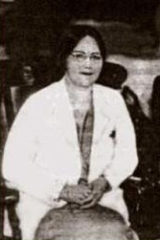
Mary Broadfoot Walker
Encyclopedia

Physostigmine
Physostigmine is a parasympathomimetic alkaloid, specifically, a reversible cholinesterase inhibitor. It occurs naturally in the Calabar bean....
in the treatment of the condition myasthenia gravis
Myasthenia gravis
Myasthenia gravis is an autoimmune neuromuscular disease leading to fluctuating muscle weakness and fatiguability...
.
Mary Walker was born at Croft-an-Righ, Wigtown
Wigtown
Wigtown is a town and former royal burgh in the Machars of Galloway in the south west of Scotland. It lies south of Newton Stewart and east of Stranraer. It has a population of about 1,000...
, Scotland
Scotland
Scotland is a country that is part of the United Kingdom. Occupying the northern third of the island of Great Britain, it shares a border with England to the south and is bounded by the North Sea to the east, the Atlantic Ocean to the north and west, and the North Channel and Irish Sea to the...
in 1888, one of four children and the daughter of a Judge. After school she trained in medicine at Glasgow & Edinburgh Medical College for Women, graduating with MBChB in 1913. During the First World War she served with the Royal Army Medical Corps
Royal Army Medical Corps
The Royal Army Medical Corps is a specialist corps in the British Army which provides medical services to all British Army personnel and their families in war and in peace...
at the 63rd General Hospital, Malta
Malta
Malta , officially known as the Republic of Malta , is a Southern European country consisting of an archipelago situated in the centre of the Mediterranean, south of Sicily, east of Tunisia and north of Libya, with Gibraltar to the west and Alexandria to the east.Malta covers just over in...
. In 1920 she became a salaried Assistant Medical Officer in "Poor Law Service"
Poor Law
The English Poor Laws were a system of poor relief which existed in England and Wales that developed out of late-medieval and Tudor-era laws before being codified in 1587–98...
at St. Alfege's Hospital, Greenwich, London, where she worked until 1936. During this time she was awarded Membership of the Royal College of Physicians
Membership of the Royal College of Physicians
Membership of the Royal Colleges of Physicians is a postgraduate medical diploma. The examinations are run by the Federation of the Medical Royal Colleges of the United Kingdom – the Royal College of Physicians of London, the Royal College of Physicians of Edinburgh, and the Royal College...
, London, in 1932. She then worked at St. Leonard's Hospital, Shoreditch, St. Francis' Hospital, Dulwich and St. Benedict's Hospital, Tooting, before retiring to Croft-an-Righ in 1954.
In 1934, while working at St. Alfege's Hospital, Dr. Walker discovered that the subcutaneous injection of physostigmine could temporarily reverse the muscle weakness found in patients suffering from myasthenia gravis. She had noted that the symptoms and signs of myasthenia were similar to those found in curare
Curare
Curare is a common name for various arrow poisons originating from South America. The three main types of curare are:* tubocurare...
poisoning, and physostigmine was used as an antidote to curare poisoning at that time. The first case of myasthenia gravis successfully treated with physostigmine was published in the Lancet
The Lancet
The Lancet is a weekly peer-reviewed general medical journal. It is one of the world's best known, oldest, and most respected general medical journals...
in June 1934.
In 1935 Mary Walker was the first to recognise the association between the condition familial periodic paralysis
Hypokalemic periodic paralysis
Hypokalemic periodic paralysis is a rare channelopathy characterized by muscle weakness or paralysis with a matching fall in potassium levels in the blood...
and hypokalaemia (low blood potassium levels). She also described the glucose challenge test used in diagnosing hypokalaemic periodic paralysis and the use of intravenous potassium in its treatment. During 1935 her research on myasthenia was incorporated into her MD thesis which was submitted via the University of Edinburgh
University of Edinburgh
The University of Edinburgh, founded in 1583, is a public research university located in Edinburgh, the capital of Scotland, and a UNESCO World Heritage Site. The university is deeply embedded in the fabric of the city, with many of the buildings in the historic Old Town belonging to the university...
, and for which she received a Gold Medal.
Although she never became a Fellow of the Royal College of Physicians
Royal College of Physicians
The Royal College of Physicians of London was founded in 1518 as the College of Physicians by royal charter of King Henry VIII in 1518 - the first medical institution in England to receive a royal charter...
, she was awarded the Jean Hunter Prize in 1962 "for the advancement of research into the treatment of nervous exhaustion and for her original contribution to the fundamental knowledge of the nature of myasthenia gravis, made while carrying out the routine duties of a medical officer at a large metropolitan hospital".
After her retirement in 1954, she continued to work part time at the Glasgow Royal Maternity & Women's Hospital, and remained active in the field of myasthenia gravis. Her 1973 article also describes the Mary Walker Effect, a clinical sign found in myasthenia gravis. She died in September 1974 at the age of 86.

